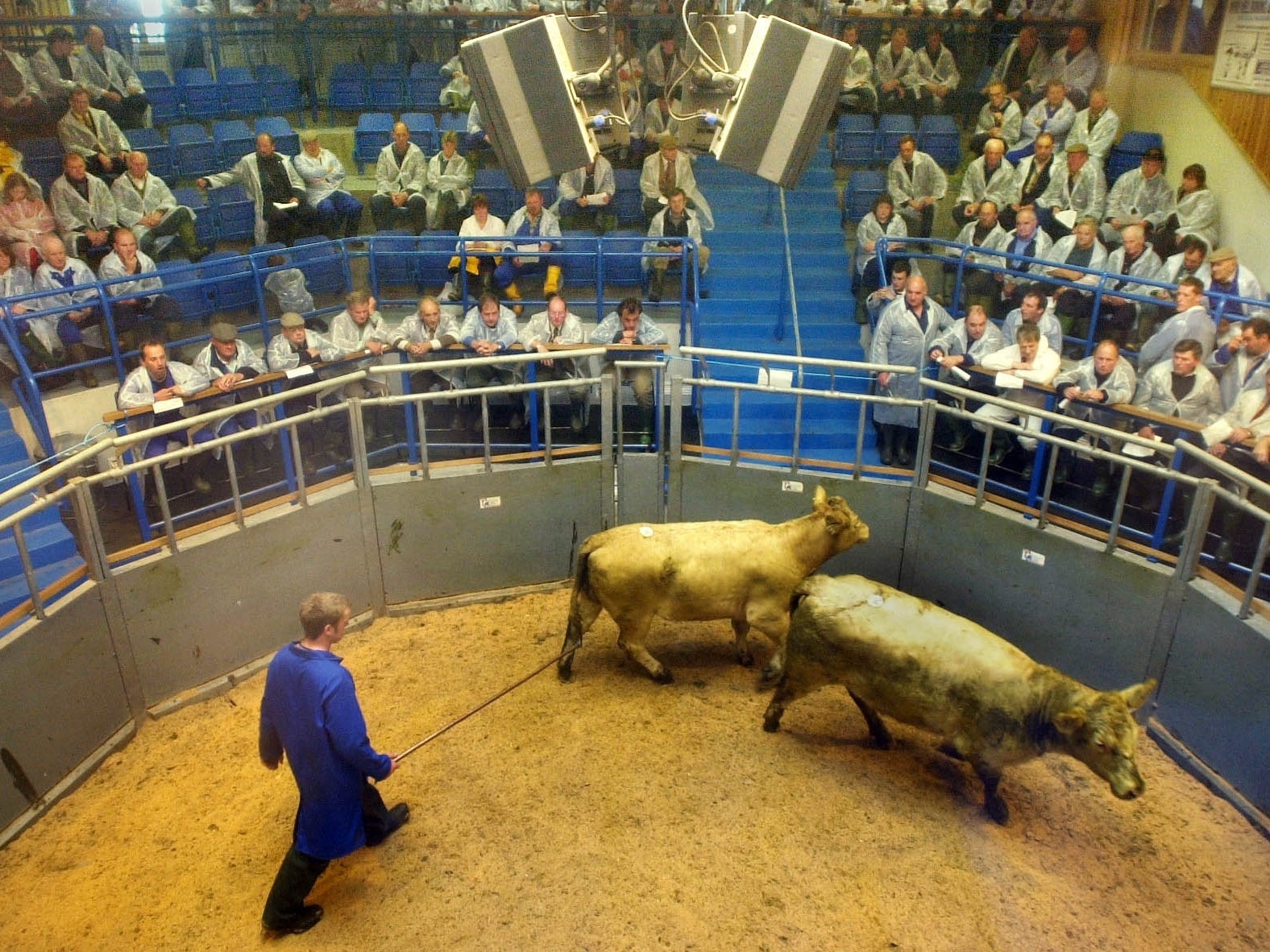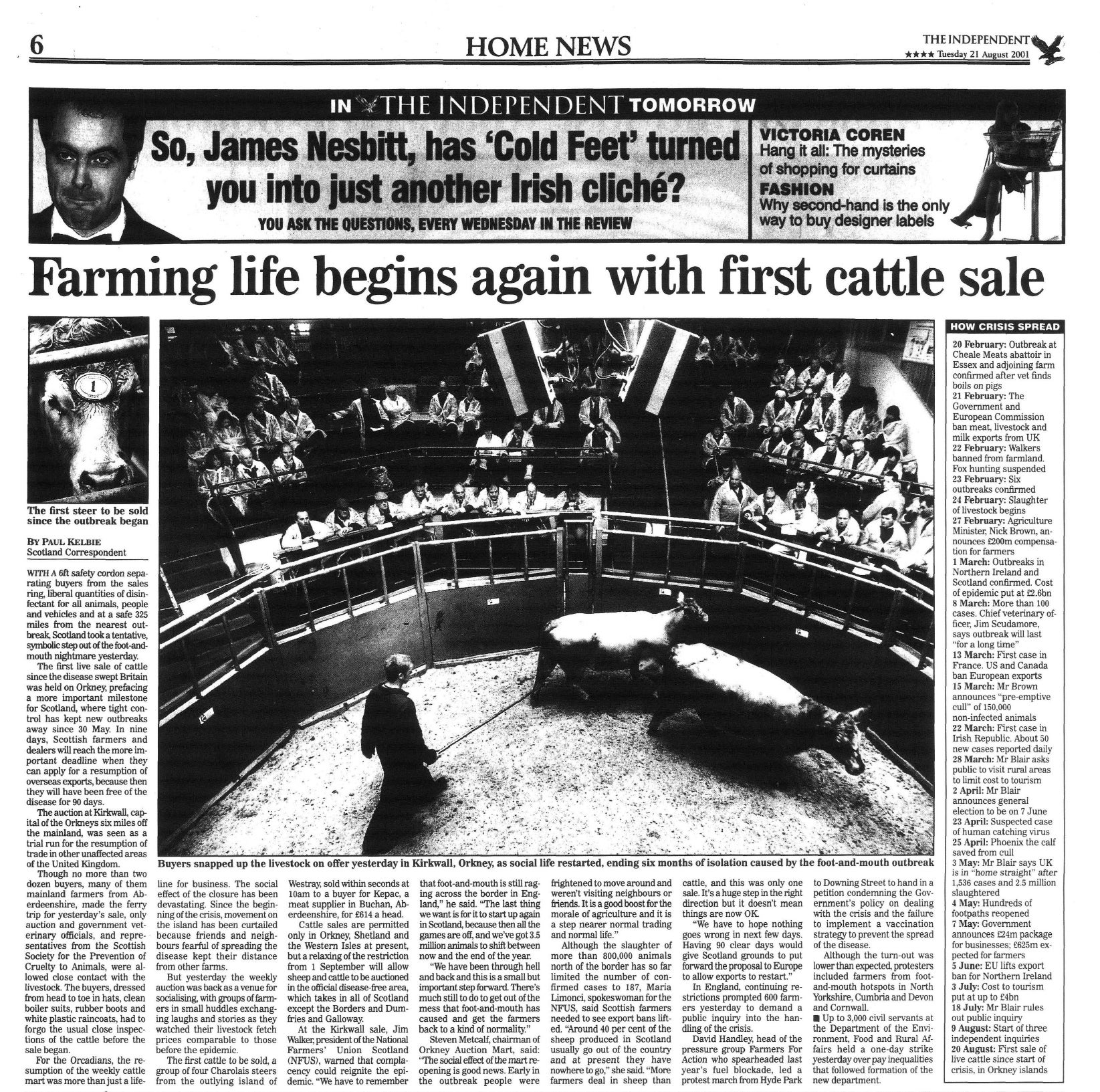Six months after foot-and-mouth outbreak, farming life began again with first cattle sale
For the Orcadians, the resumption of the weekly cattle mart was more than just a lifeline for business, says Paul Kelbie

With a 6ft safety cordon separating buyers from the sales ring, liberal quantities of disinfectant for all animals, people and vehicles and at a safe 325 miles from the nearest outbreak, Scotland took a tentative, symbolic step out of the foot-and-mouth nightmare yesterday.
The first live sale of cattle since the disease swept Britain was held on Orkney, prefacing a more important milestone for Scotland, where tight control has kept new outbreaks away since 30 May. In nine days, Scottish farmers and dealers reach the more important deadline when they can apply for a resumption of overseas exports, because then they will have been free of the disease for 90 days.
The auction at Kirkwall, capital of the Orkneys six miles off the mainland, was seen as a trial run for the resumption of trade in other unaffected areas of the United Kingdom.
Though no more than two dozen buyers, many of them mainland farmers from Aberdeenshire, made the ferry trip for yesterday’s sale, only auction and government veterinary officials, and representatives from the Scottish Society for the Prevention of Cruelty to Animals, were allowed close contact with the livestock. The buyers, dressed from head-to-toe in hats, clean boiler suits, rubber boots and white plastic raincoats, had to forgo the usual close inspections of the cattle before the sale began.
For the Orcadians, the resumption of the weekly cattle mart was more than just a lifeline for business. The social effect of the closure has been devastating. Since the beginning of the crisis, movement on the island has been curtailed because friends and neighbours fearful of spreading the disease kept their distance from other farms.
But yesterday the weekly auction was back as a venue for socialising, with groups of farmers in small huddles exchanging laughs and stories as they watched their livestock fetch prices comparable to those before the epidemic.
The first cattle to be sold, a group of four Charolais steers from the outlying island of Westray, sold within seconds at 10am to a buyer for Kepac, a meat supplier in Buchan, Aberdeenshire, for £614 a head.

Cattle sales are permitted only in Orkney, Shetland and the Western Isles at present, but a relaxing of the restriction from 1 September will allow sheep and cattle to be auctioned in the official disease-free area, which takes in all of Scotland except the Borders and Dumfries and Galloway.
How the crisis spread
20 February: outbreak at Cheale Meats abattoir in Essex and adjoining farm confirmed after vet finds boils on pigs
21 February: government and European Commission ban meat, livestock and milk exports from Britain
22 February: walkers banned from farmland. Fox hunting suspended
23 February: six outbreaks confirmed
24 February: slaughter of livestock begins
27 February: agriculture minister Nick Brow, announces £200m compensation for farmers
1 March: outbreaks in Northern Ireland and Scotland confirmed. Cost of epidemic put at £2.6bn
8 March: more than 100 cases. Chief veterinary officer Jim Scudamore says outbreak will last ‘for a long time’
13 March: first case in France. US and Canada ban European exports
15 March: Brown announces ‘pre-emptive cull’ of 150,000 non-infected animals
22 March: first case in Ireland. About 50 new cases reported daily
28 March: Blair asks public to visit rural areas to limit cost to tourism
2 April: Blair announces general election will be held on 7 June
23 April: suspected case of human catching virus
25 April: Phoenix the calf saved from cull
3 May: Blair says UK is in ‘home straight’ after 1,536 cases and 2.5 million slaughtered
4 May: hundreds of footpaths reopened
7 May: government announces £24m package to help businesses; £625m expected for farmers
5 June: EU lifts Northern Ireland export ban
3 July: cost to tourism put at up to £4bn
18 July: Blair rules out public inquiry
9 August: start of three independent inquiries
20 August: first sale of live cattle since start of crisis, in Orkney islands
At the Kirkwall sale, Jim Walker, president of the National Farmers’ Union Scotland (NFUS), warned that complacency could reignite the epidemic. “We have to remember that foot-and-mouth is still raging across the border in England,” he said. “The last thing we want is for it to start up again in Scotland, because then all the games are off, and we’ve got 3.5 million animals to shift between now and the end of the year.
“We have been through hell and back and this is a small but important step forward. There’s much still to do to get out of the mess that foot-and-mouth has caused and get the farmers back to a kind of normality.”
Steven Metcalf, chairman of Orkney Auction Mart, said: “The social effect of the mart reopening is good news. Early in the outbreak people were frightened to move around and weren’t visiting neighbours or friends. It is a good boost for the morale of agriculture and it is a step nearer to normal trading and normal life.”
Although the slaughter of more than 800,000 animals north of the border has so far limited the number of confirmed cases to 187, Maria Limonci, spokeswoman for the NFUS, said Scottish farmers needed to see export bans lifted. “Around 40 per cent of the sheep produced in Scotland usually go out of the country and at present they have nowhere to go,” she said. “More farmers deal in sheep than cattle, and this was only one sale. It’s a huge step in the right direction but it doesn’t mean things are now OK.
“We have to hope nothing goes wrong in next few days. Having 90 clear days would give Scotland grounds to put forward the proposal to Europe to allow exports to restart.”
In England, continuing restrictions prompted 600 farmers yesterday to demand a public inquiry into the handling of the crisis.
David Handley, head of the pressure group Farmers For Action who spearheaded last year’s fuel blockade, led a protest march from Hyde Park to Downing Street to hand in a petition condemning the government’s policy on dealing with the crisis and the failure to implement a vaccination strategy to prevent the spread of the disease.
Although the turnout was lower than expected, protesters included farmers from foot-and-mouth hotspots in North Yorkshire, Cumbria and Devon and Cornwall.
Up to 3,000 civil servants at the Department of the Environment, Food and Rural Affairs held a one-day strike on 20 August 2001 over pay inequalities that followed formation of the new department
This article first appeared in The Independent on 21 August 2001
Join our commenting forum
Join thought-provoking conversations, follow other Independent readers and see their replies
0Comments